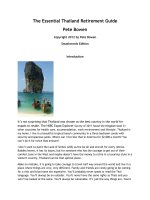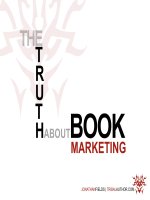The Essential brand book
Bạn đang xem bản rút gọn của tài liệu. Xem và tải ngay bản đầy đủ của tài liệu tại đây (1.27 MB, 334 trang )
The Essential Brand
Book: Over 100
Techniques to Increase
Brand Value
KOGAN PAGE LIMITED
Iain Ellwood
THE ESSENTIAL
BRAND
BOOKover 100 techniques to increase brand value
To my parents, Rob and Jan, for their encouragement
and support throughout all the years.
THE ESSENTIAL
BRAND
BOOKover 100 techniques to increase brand value
2nd edition
IAIN ELLWOOD
First published in 2000
Reprinted 2001
Second edition 2002
Apart from any fair dealing for the purposes of research or private study, or criti-
cism or review, as permitted under the Copyright, Designs and Patents Act 1988,
this publication may only be reproduced, stored or transmitted, in any form or by
any means, with the prior permission in writing of the publishers, or in the case of
reprographic reproduction in accordance with the terms and licences issued by the
CLA. Enquiries concerning reproduction outside these terms should be sent to the
publishers at the undermentioned address:
Kogan Page Limited
120 Pentonville Road
London N1 9JN
www.kogan-page.co.uk
© Iain P Ellwood, 2000, 2002
The right of Iain P Ellwood to be identified as the author of this work has been
asserted by him in accordance with the Copyright, Designs and Patents Act 1988.
British Library Cataloguing in Publication Data
A CIP record for this book is available from the British Library.
ISBN 0 7494 3863 0
Cover design by Richard Crighton
Typeset by Saxon Graphics Ltd, Derby
Printed and bound in Great Britain by Biddles Ltd, Guildford and King’s Lynn
www.biddles.co.uk
CONTENTS
The author ix
Acknowledgements xi
Introduction 1
Brand communication
1 Contemporary branding 9
Branding, marketing and the business environment
2 Brand configuration 19
Structuring the brand and the organization
3 Service, retail and trade branding 42
Effective strategies for different sectors
4 Brand media 64
Established communication channels and techniques
5 New media brandsites 98
Strategies for the digital economy
Brand definition
6 Brand positioning 121
Creating a strong core DNA for a brand
7 Cognitive brand dimensions 147
Defining the rational benefits of a brand
8 Emotional brand dimensions 163
Defining the emotional benefits of a brand
v
Brand equity
9 Legal protection 181
Protecting the brand and its expression
10 Financial assets 198
Valuing the brand as a business asset
Brand strategy
11 Brand planning 217
Strategies for brand revitalization, brand extension and
new brand creation
12 Researching consumer behaviour 241
Evaluating the research process and methodologies
13 Corporate brand management 266
The CEO as brand manager and how to inspire every
employee to take responsibility for the brand
14 The future 284
New rules for the new economy
Glossary 302
Bibliography 310
Index 317
Contents
vi
Contents
vii
Brand
definition
Brand
strategy
Brand
communication
Brand
equity
Figure 0.1 Book navigation guide
This Page Intentionally Left Blank
THE AUTHOR
Iain has over 10 years’ international experience living and working
in Japan, Hong Kong, the Netherlands and the United States as a
brand marketing strategist for blue-chip companies. He is a leading
strategist at the consulting firm Prophet. He has led award-winning
international projects for clients including BT, Vodafone, Swiss
Airlines, Guinness World Records, Philips and the LE Group.
His extensive psychological and sociological knowledge have
shaped corporate strategy and customer-focused propositions that
increase revenue. This approach has proved equally effective for
delivering internal brand campaigns that motivate and educate
employees.
Iain is a regular press commentator on strategic marketing and
branding issues for The Economist, the BBC and numerous trade
magazines. He is a frequent speaker on marketing, innovation and
communications. He also occasionally lectures on the MBA courses
at the London Business School (LBS).
Iain is a Member of the Chartered Institute of Marketing (MCIM),
a Member of the Marketing Society and a Fellow of the Royal
Society of Arts (FRSA).
Prophet is a strategic professional services firm committed to
building and growing great brands and businesses. If you would
like to hear more about how it can help your business, please
contact Iain at
ix
This Page Intentionally Left Blank
ACKNOWLEDGEMENTS
The author would like to personally thank the following marke-
teers, business owners, colleagues, clients and friends for their
insightful ideas and for their constant encouragement: Liza Bingley,
James Cockerille, Charles Colquhoun, David Cox, Richard
Crighton, Alastair Kingsland, Graham Moore, Jeremy Myerson, Ian
Woodhouse, Grant Usmar, Madelijne Vermeij.
Thanks are also due to those who were kind enough to be inter-
viewed for this project and are quoted in the text:
Michael Abrahams, Abrahams Design
Anneke Elwes, brand planner
Gary Lockton, North Creative Consultancy
Celia Lury, Goldsmiths College, University of London
Will Maskell, PI3 Ltd
Jane Merriman, William Grant & Sons
Joanne Wallace, McVities
Simon Waterfall, Poke Consultancy
Professor James Woudhuysen
Peter York, SRU Ltd
Thanks to Victoria Groom at Kogan Page for those interesting
lunchtime discussions and patient waiting for the final draft.
Finally, many thanks to my family – Rob, Jan, Andrew and Peter –
for all their care and encouragement.
xi
This Page Intentionally Left Blank
1
INTRODUCTION
The brand is one of the most valuable assets that any business
possesses:
• Branding provides the key communication with customers.
• Branding creates critical differentiators in the marketplace.
• Branding shapes internal company culture.
• Branding leverages the intellectual assets of the business.
• Branding generates increased business performance.
Yet despite all these benefits, branding is still too often seen as a
mere tactical tool rather than a business strategy. There is a huge
financial potential for businesses that can maximize their brand
equity. The excellent Return On Investment (ROI) of any branding
programme can be seen with brands such as Orange (mobile
phones), Unilever, Jaguar and Disney.
Brand creation and brand management are essential for success
and profitability in the business process. This book provides a
holistic overview of the essential leading methods of brand analysis,
brand creation, brand development and brand management. It is a
hands-on guide for marketing and business professionals and those
in higher education.
Readers gain an insight into all the components of brand manage-
ment including a wide range of business models and techniques that
help to build strong and effective brands in the marketplace.
Illustrated with specific examples, it provides a toolbox of proven
techniques on how to analyse and choose the most successful combi-
nation of brand dimensions on which to develop brands. It is a com-
panion resource for the management of all brand issues.
The terms ‘brand’ and ‘branding’ have become over-used during
the last few years and have become devalued as a result. This book
revalues all the management concepts of branding by dealing with
each in a distinctive chapter. The book therefore covers all the
essential components of brand management but ensures that they
are described and illustrated with clarity.
Who the book is aimed at
This book is aimed at everyone who comes into daily contact with
brands, products and services. It is for use by those within industry
and business responsible for the marketing, visual communication
and management of brands and their expression through all media
types. The CEO is the ultimate brand manager but everyone in the
organization is responsible for delivering the brand vision.
The task of managing brands is as important to niche entrepreneurs
as it is for small business owners and large corporate businesses. The
increasing professionalization of charity work means that it is equally
pertinent to non-profit organizations as those who are quoted on the
stock markets around the world. Any group of people who provide a
product or service to others need to communicate the availability and
benefit of that proposition to all stakeholders. A strong brand acts as
the source and the medium for that communication process.
How to use the book
The book is divided into four key components to make it easier to
find the material you need. Each component is easy to locate by the
titles at the top of the pages. Each chapter within the four compo-
nents relates strongly to each other but is also interrelated to all the
other chapters. Those with less knowledge may wish to start at the
beginning, while those more advanced will proceed directly to
the relevant chapter first. The glossary at the end of the book will help
to define all the terms that are used in the book and the industry.
Brand communication
Chapter 1 introduces the concepts of brands and brand manage-
ment and explains why they are so important for a business. It
demonstrates the connection between the current business model
The essential brand book
2
of a market and an approach to brand management. This chapter
illustrates the role of a brand as the key communication tool
between the business and all its stakeholders.
Chapter 2 describes the methods of brand management in the
context of other marketing and business disciplines. It demon-
strates the characteristics and structuring of sole brands, validating
brands, range brands, line brands and product brands. This chapter
illustrates the use of brand extensions and their hierarchies
reflecting the business organization.
Chapter 3 emphasizes the unique characteristics of service, retail
and business-to-business brand management. This introduces the
issues that impact on the branding of intangible services like time-
based brand delivery. It also covers the use of complex decision-
making units (DMUs) within an organization and emphasizes the
need for a brand to reflect compound values and dimensions to dif-
ferent audiences at different times.
Chapter 4 describes the methods of communication between
business and customers. It analyses the advantages and disadvan-
tages of different media types, including above the line and below
the line media. There is an in-depth look at packaging and espe-
cially its function in FMCG brand communication. Finally, as media
are often a bought-in service, there is an introduction to the best
way to approach and use agencies.
Chapter 5 analyses the emerging new media of the Internet and
digital television and their impact and opportunities for brand
management. It illustrates the strategic development of new media
brandsites and highlights the key tactics for brand communication.
This chapter also introduces the business model of e-commerce,
intranets and extranets.
Brand definition
Chapter 6 describes how the brand DNA, the essence of a brand, is
created and refined. It identifies the areas of greatest potential for
specific brand imagery and identity. This chapter describes the
positioning and development of the brand proposition and person-
ality. It also demonstrates the tools for brand name creation and
assessment, together with the process for the creation of a corporate
identity, logos and trade marks.
Chapter 7 defines the cognitive or rational dimensions of a brand
proposition and emphasizes their use in communication. It illus-
Introduction
3
trates the strategic and tactical uses of cognitive dimensions and
tools for brand management. It also introduces Maslow’s hierarchy
of needs and demonstrates its use in defining customer needs.
Chapter 8 describes how the pleasure principle can be used to
define and measure deep customer satisfaction. It characterizes the
emotional dimensions of a brand and their ability to fulfil consumer
needs. It also illustrates the strategic choices for emotional brand
dimension development.
Brand equity
Chapter 9 clarifies the legal definitions that a brand mark and
intellectual property can use for protection. It characterizes the dif-
ferences between a trade mark, copyright, a design patent and trade
dress. It describes the application process for gaining trade mark
protection and illustrates the use of design elements to increase pro-
tection.
Chapter 10 describes the increasing use of a financial evaluation
of intangible brand assets on the balance sheet. It describes the
current key valuation methods including the multiple criteria often
used by leading accountants. It introduces the topics of licensing
and royalty agreements as another type of financial performance
evaluation.
Brand strategy
Chapter 11 describes the brand planning process and introduces
essential methods and tools for effective brand management. It
analyses and compares a range of strategies and tactics for brand
creation and development. There is an explanation of key brand
extension strategies and portfolio management tools.
Chapter 12 introduces the research processes needed for under-
standing and categorizing consumer needs. It illustrates the advan-
tages and disadvantages of primary, secondary, exploratory,
descriptive, causal, quantitative and qualitative research
approaches. It also illustrates a large range of strategic and tactical
research methods and media.
Chapter 13 demonstrates why the real brand manager is the CEO
and the importance of internal brand communication. It illustrates
the internal brand culture and its effect on productivity. This
The essential brand book
4
chapter describes why and how all employees are responsible for
and can be motivated towards the delivery of the brand vision. It
demonstrates an effective internal brand communications pro-
gramme.
Chapter 14 informs about the new rules for brand management
in the new economy. It illustrates the opportunities for new busi-
ness models that create better customer buy-in and satisfaction with
a brand. It highlights the importance of an integrated approach to
new and traditional media in brand communication.
The Glossary provides a useful quick guide to check terms used
throughout the book and industry. The Bibliography references
works mentioned in the text and suggests works that will be invalu-
able for the brand manager who wants to develop further in all the
specific areas of brand management. Finally, the Index provides a
quick finder for essential topics, people and processes of brand
management. It cross-references topics throughout the book.
Introduction
5
This Page Intentionally Left Blank
BRAND
COMMUNICATION
This first of the four parts in the book introduces the standard oper-
ating procedures for brands across key business models, market
categories, media types and new virtual media opportunities. It
covers all the important issues of current brand management
thinking and introduces new techniques to maximize potential
gains. It includes:
• introduction to brand management;
• brand hierarchy and configuration;
• service branding;
• retail branding;
• business-to-business branding;
• communication media;
• above the line media;
7
Brand
definition
Brand
strategy
Brand
communication
Brand
equity
Figure 1.0 Brand communication
• below the line media;
• packaging;
• Internet branding;
• digital television branding.
Brand communication
8
9
Objectives
• Demonstrate why brands are important to every business
and consumer today.
• Define the nature of a brand and its relationship to a
product or service.
• Illustrate the connection between business models and
brand development throughout history.
• Clarify all the stakeholders and media channels available to
brand managers.
CONTEMPORARY
BRANDING
Branding, marketing and the business
environment
This chapter introduces the concept of brands, the scope of
branding and brand management and contextualizes the material
of the later chapters. Key definitions and perspectives on brand
management will be introduced to frame the subject and its under-
lying drivers. The history of brands will be illustrated together with
their relationship with business models throughout the past,
present and future opportunities.
Branding is now recognized as the core tool that connects all the
business stakeholders through all the media channels. These will be
briefly introduced to map out the connections between the later
chapters.
CHAPTER ONE
Why branding is important today
A survey last year by the Henley Centre revealed that the public
trust brand names such as Kellogg’s, Heinz and Marks & Spencer
more than Parliament, the police and the legal system (Sunday
Times, ‘A can of worms is a bad diet’, 5 April 1998). This research
highlights the importance of the relationship between consumers
and key brands; and shows that it has strengthened to such an
extent that it is now healthier than the relationship with our social
structures. This is evidence of the power of consumer culture and
the liberal free market economics of the westernized world. Three
trends support this belief:
• Individualism: westernized societies recognize the fragmenta-
tion of our personal and social identities and this encourages
self-identity construction through the consumption of material
goods and services: you are what you buy.
• Globalization: individual consumers are becoming a smaller
part of a much larger world and need to find easy and quick
ways to guide them through that world.
• Symbolic experiences are increasingly in demand. Consumers
are buying experiences rather than commodities whose con-
tents are largely image driven, intangible and symbolic.
The combination of these three trends has led to a shift away from
producer or sales led marketing towards customer focused and cus-
tomer driven business models. This means that understanding
what motivates and satisfies the customer is the key to successful
modern business practices. The brand acts as the logical and
primary connection and mode of communication between the pro-
ducer and the consumer. For brand managers, this prioritizes the
modelling of a brand personality along the format of human rela-
tionships, since customers already have the skills and experience of
how to relate to other people.
Definition of a brand
There are many definitions of what a brand represents and to which
audiences; the simplest are the following:
Brand communication
10
Product/service + Aura = Brand communication
Product/service + distinctive value = Brand equity
The distinctive value is the rational and emotional added value that
employees and customers feel is part of their consumption of the
proposition. This creates a price premium for the business and adds
equity to the balance sheet.
The aura represents the communication of the signifying and dif-
ferentiating characteristics of the proposition.
At the core of all successful brands there is always a successful
product or service. The product or service can be imagined or visu-
alized as a hard, white golf ball, while the brand is a translucent,
multi-coloured ball of gas the size of a large balloon surrounding
that golf ball. The balloon’s membrane is the flexible personality that
can be squeezed and changed to different accents of personalities,
while the central golf ball remains. The consumer’s decision to buy a
specific brand is mostly based on the character of the balloon, while
the underlying use is often based on the character of the golf ball.
The brand therefore acts as a kind of flag, waving to consumers,
creating awareness of the product and differentiating it from other
competitors. This communication function is the core of brand
management for a business. The extent to which brands can com-
municate a message with the consumer is still under debate. Celia
Lury, sociologist at Goldsmiths College, University of London,
defines a brand as a marker: ‘A marker is very different from a
message in the sense that the content of a marker is much less, but
nevertheless the fact that it points to something recognizable is as
important as the meaning in a message.’
Other commentators (Campbell, 1998; McLuhan, 1968) argue
that brands have a more significant role as the message itself. Both
viewpoints stress the role of a brand in embodying shared meaning
between the producer and the consumer. This shared meaning is
the aura the brand has developed in consumer culture over time. It
is the recognizability and differentiation that allows consumers to
make detailed choices between goods and services that are virtually
identical.
Peter York, founding partner of SRU Ltd, stated, ‘A brand should
ensure a long-term and forgiving relationship with its audiences.’
The emphasis on the long term is crucial for the ecology of a business:
it is easy to dilute a brand’s equity by selling down. Any advantage
would only last for a short period before the brand was reduced to a
commodity with little or no differentiation in the marketplace,
Contemporary branding
11
relying on a price as the key purchasing driver. The sensitivity of a
‘forgiving relationship’ focuses on the one-to-one relationships that
consumers have with specific brands. It is a relationship in human
terms and as such can have a flowing character rather than one that is
flat but steady. The strength of a brand is shown when it retains cus-
tomer support through a difficult period.
How business models have driven brand
development throughout history
The visible marking or branding of goods is a practice that is over
2,000 years old. The Greeks and Romans, with their sophisticated
economic and commercial enterprise, developed ‘maker marks’ to
establish the origins of specific goods. This was required because
the Roman Empire had expanded, creating a great distance
between producer and consumer. Previously, the producer and con-
sumer would have had a personal relationship in the same village
or town, and a personal bond of trust existed. The increase in dis-
tance, and greater import and export trade issues, meant that that
level of personal trust was impossible. The consumer had to rely on
the evidence of the maker’s mark to reassure them that the goods
they were purchasing were of the same quality.
The trade in goods also required the marketing of those goods in
a fledgling competitive environment. This meant the distinguishing
of specific regional origins and master craftsman for the consumer.
These early marks related to the types of goods on sale: a butcher’s
mark, a spice merchant’s mark or a carpenter’s mark. These marks
were often little more than a visual representation of the goods pro-
vided – a hog’s head or a hammer and chisel of a carpenter. They
were the first representations of a brand mark, literal depictions but
also characterizations.
The second important origin of the brand mark was the signature
applied to a piece of work, on the base of an earthenware bowl, or a
manuscript or a carved statue. They all represent the identity of the
maker and act, as with any signature, as an assurance, a personal
recommendation and guarantee of the goods. The signature also
helps to establish the quality of the goods in comparison with other
makers or merchants in the same field. Where the symbol of the
goods, such as a jug of wine, establishes the type of goods, the name
establishes the origin of goods (most names at that time reflected
Brand communication
12









